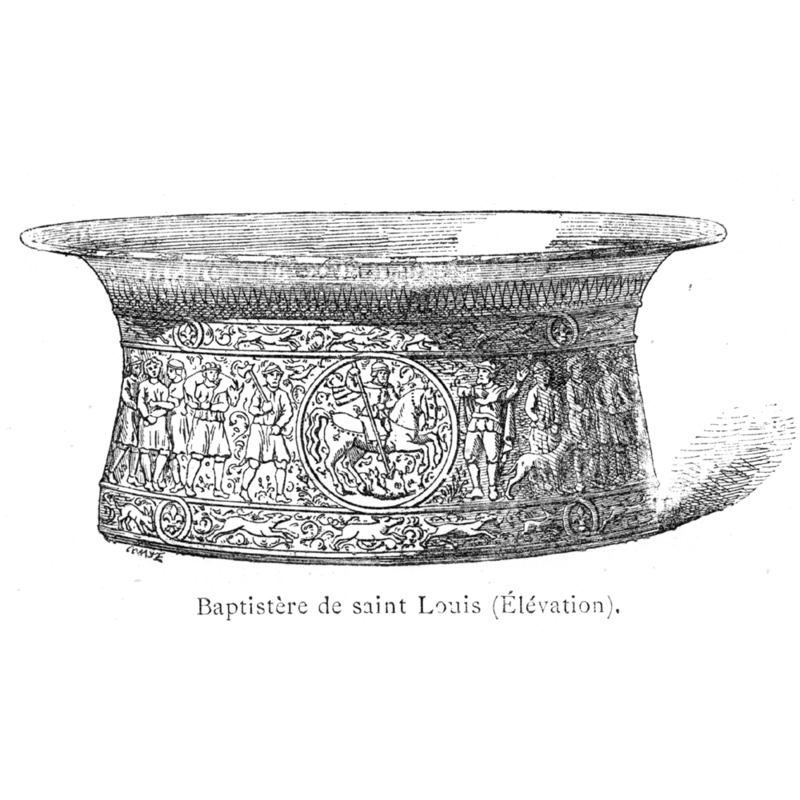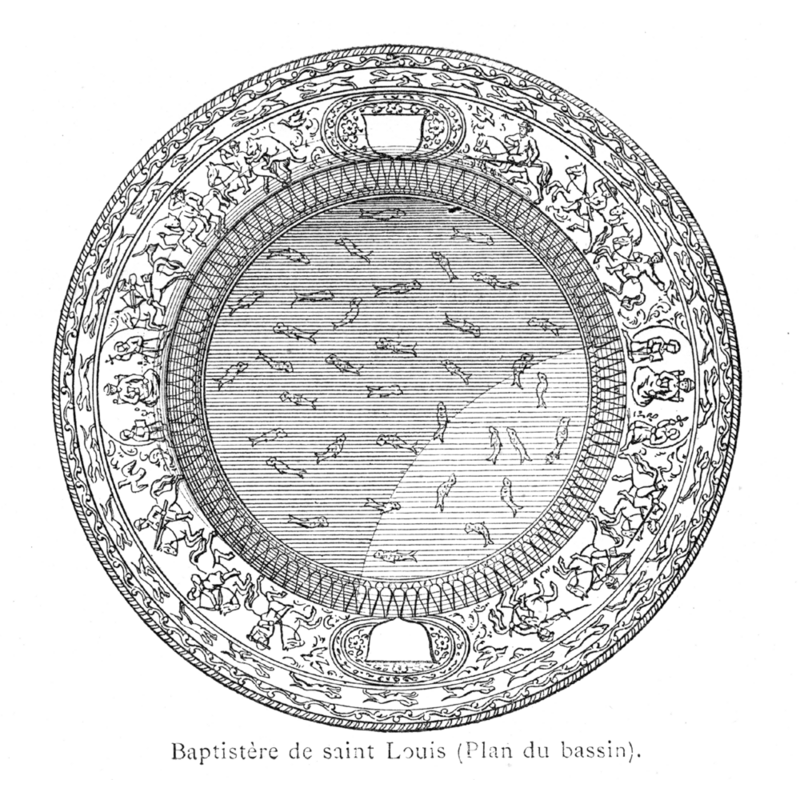Paris No. 18 / Lutetia Parisiorum

Image copyright © [in the public domain]
PD
Results: 13 records
B1R: design element - motifs - floral - fleur-de-lis - in a circle
B1R02: animal - mammal - dog
B2R01: human figure - warrior - on horseback - dragon - fighting - St. George?
B2R02: hunting scene
B3R01: animal - mammal - dog
BBU01: design element - motifs - zigzag
R01: hunting scene
R02: sacrament - eucharist?
R03: symbol - shield - blank
view of basin
view of basin - detail
view of basin - elevation
INFORMATION
FontID: 02910LOU
Object Type: Baptismal Font1
Museum and Inventory Number: Musée du Louvre, Paris (Département des arts de l'Islam)
Church/Chapel: Viollet-le-Duc placed in the "musée des Souverains, à Paris", ca. 1875
Church Location: 75001 Paris, France -- Tel.: +33 1 40 20 53 17
Country Name: France
Location: Ville de Paris, Île-de-France
Directions to Site: In the Louvre Museum
Ecclesiastic Region: Archidiocèse métropolitain de Paris
Date: 1290-1310? / 1330?
Century and Period: 13th - 14th century, Arabic?
Workshop/Group/Artisan: Master Muhammad ibn az-Zain [aka Mohammed ibn Zein ed Din / Muhammed Ibn-al-Zayn]
Cognate Fonts: A somewhat similar basin, "the Arenberg", at the British Museum, although its ornamentation includes scenes from the life of Christ and was probably never used or meant as a baptismal basin.
Font Notes:
Click to view
Enlart (1902) describes this font as "un bassin arabe du XIIIe siècle, destinés à des usages domestiques" and states that it has, under the name of "baptistère de Saint-Louis", served as the royal font in which the crown princes of France since Louis XIII were baptised. Enlart states that, before it went to the Louvre, it was part of the "trésor de Vincennes". Corblet describes and illustrates this "font" as being shaped like an inverted hat, "originairement un bassin arabe destiné aux ablutions"; his illustration shows a narrow band of zig-zag motif under the wide upper brim; below it another narrow band, this one with groups of four hunting dogs running towards the right side and a circled fleur-de-lis motif between them; the wide central band has different scenes of a hunt in progress, but one of the sides has a large circle in which a mounted male figure spears a dragon; at the bottom of the basin side there is another band of dogs and fleur-de-lis motif, like the upper one. The upper surface of the basin has two blank shields, at opposite sides, while the rest of the surface of the rim is covered in four concentric bands: the first, very narrow, has foliage motif; the second, equally narrow, has hunting dogs running toward the right; the third, the widest and the one containing the two shields, has several hunting scenes and, at 90-degree angles with the shields, two scenes in which there are three figures: a seated or enthroned person holds a cup or chalice; on his right, a kneeling person holds up a cross while, on the left, another kneeling person holds an open book facing the seated person; the last of the concentric bands has zig-zag motif. The bottom of the inside well of the basin is ornamented with many fish, as if swimming in the basin. Corblet suggests a date in the early 13th century and gives the material as "cuivre rouge, plaqué d'argent". (Corblet, 1881-1882, v. 2, p. 136-137). Earlier than both Corblet and Enlart, Viollet-le-Duc, rather unimpressed by the traditional claim to royal use attributed to this font, described it as "la belle cuve de travail persan dans laquelle on prétend qu'ont été baptisés les enfants de saint Loius", though he dutifully quotes the verses of the 'Baptéme de Renouerd' (Dictionnaire..., t. 5, 1875, p. 543-544). Curatola (in Mediterraneo... 2000) describes it as perhaps the masterpiece of Islamic metalwork and gives the name of the maker as Muhammad ibn az-Zain who made it between 1290 and 1310; he gives the ornamentation as: battle and hunting scenes, court entertainment, passant animals and splendid floral motifs. Described and ilustrated also in Diez (1944). Bonafoux (2008) dates it 1330 and gives some measurements; Bonafoux notes that king Louis XIII of France was baptised in it at Vincennes in 1601; by 1793 it was in the Louvre, but was taken to the church of Notre-Dame in 1856 for the baptism of the imperial prince Eugène Louis Napoléon; in the 19th century, adds Bonafoux (ibid.), the arms of France [fleurs de lys on a shield] were added to the basin; in 1893 it was displayed in the first hall dedicated to Islamic collections, which were transferred to 'Département des arts asiatiques' in 1936; in 1939 (?) it is moved to the Guimet mueseum, returning to the Louvre in 2003.
COORDINATES
Church Latitude & Longitude Decimal: 48.861111, 2.335833
Church Latitude & Longitude DMS: 48° 51′ 40″ N, 2° 20′ 9″ E
UTM: 31U 451286 5412229
MEDIUM AND MEASUREMENTS
Material: metal, copper (silver plated)
Number of Pieces: one
Font Shape: round
Basin Interior Shape: round
Basin Exterior Shape: round
Diameter (includes rim): 50.5 cm*
Basin Total Height: 23.2 cm*
Notes on Measurements: * [a/p Bonafoux (2008)]
INSCRIPTION
Inscription Language: Arabic
Inscription Notes: Corblet describes an Arabic inscription "en charactères neskry"
Inscription Location: On the "lip" of the basin
Inscription Text: [Translation into French: "Fait par maître Mohammed, fils de Zein-ed-Din, à qui Dieu fasse miséricorde"]
Inscription Source: Translation by M. de Longperrier in Corblet (1881-1882, v. 2, p. 137)
REFERENCES
Bonafoux, Pascal, Les coulisses du Louvre, Paris: Chêne, 2008
Corblet, Jules, Histoire dogmatique, liturgique et archéologique du sacrement de baptême, Paris: V. Palme, 1881-1882
Curatola, Giovanni, "Influenza cristiana della Siria e dell'Egitto", 2000, pp. 149-151; p. 149 and ill. on p. 151
Diez, Ernst, Iranische Kunst, Wien: Wilhelm Andermann Verlag, 1944
Enlart, Camille, Manuel d'archéologie française depuis les temps mérovingiens jusqu'à la Renaissance, Paris: Alphonse Picard & fils, 1902
Viollet-le-Duc, Eugène-Emmanuel, Dictionnaire raisonné de l'architecture française du XIe au XVIe siècle, Paris: Morel & Cie, 1854-1868

